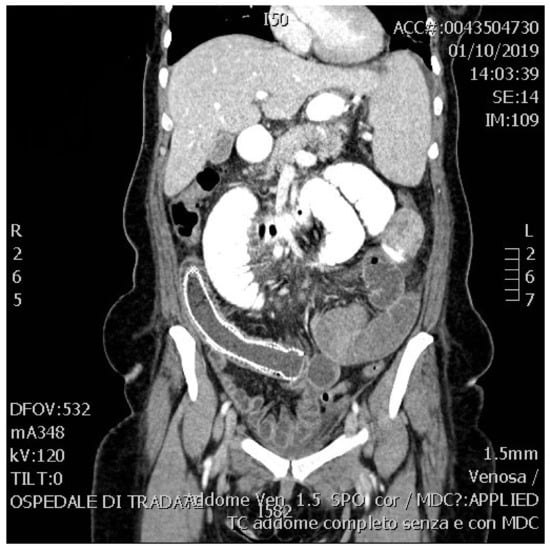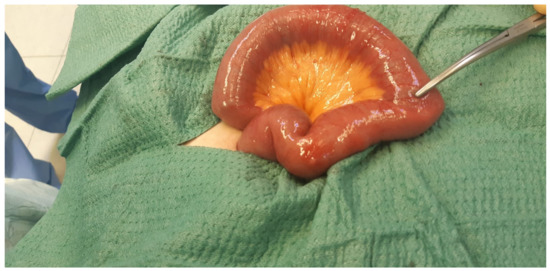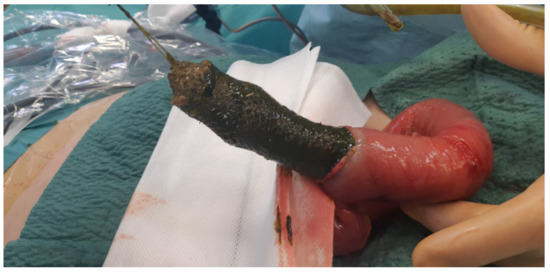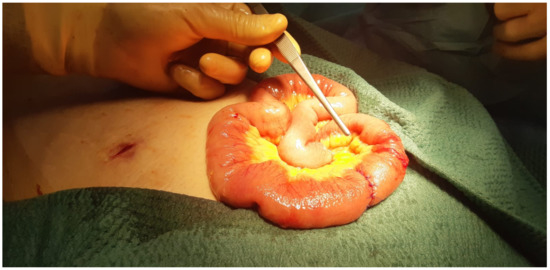Abstract
Gastric leak is a serious complication of sleeve gastrectomy with a well-documented morbidity and mortality. Depending on the series the leak rate ranges between 1 and 5%. The treatment of sleeve gastrectomy leak is still challenging. Different procedures have been described in management of gastric leak, both surgical and endoscopic. The treatment of gastric leaks depends on the extent of the staple-line leak, the site of the leak and its association with stenosis. As published data are limited, there are no still standardized guidelines on best treatment. One of the most commonly used option in the treatment of gastric leak is esophageal stent. Its success rate reaches 70–80% but it is burdened by some complications. Stent migration is the most common complication in the placement of esophageal stent.We present a challenging surgical in which case the use of an esophageal stent for the treatment of a sleeve gastrectomy leak gained the resolution of the leak but was complicated by bowel obstruction due to migration of the stent.
1. Introduction
A sleeve gastrectomy (SG) is one of the most performed bariatric procedures worldwide [1]. One of the most feared complications of SG is gastric leak, occurring in 1 to 5% of the cases [2].
The management of gastric leak is complex and not yet standardized. Several different treatment strategies have been described and include both surgical and endoscopic approaches. The first consists of a laparoscopic revision that includes re-suturing and drainage. The second includes the endoscopic delivery of different types of stents, closure devices, internal drainages, and suturing [3,4].
We report on a case of gastric leak after sleeve gastrectomy that was initially treated with a self-expandable covered metal stent, but further complicated by its migration. We describe our management of the case and confront it with the evidence from the literature.
2. Presentation of the Case
A 41-year-old woman with a body mass index (BMI) of 42 kg/m2 underwent a laparoscopic SG. The patient was discharged five days after surgery after a negative oral contrast study. One month later, the patient was admitted to Emergency Department complaining of fever and abdominal pain. Blood exams revealed leukocytosis and elevated C-Reactive Protein (CRP). An abdominal computed tomography (CT) scan with oral contrast revealed a proximal gastric leak of the sleeve and a subphrenic abscess.
The patient underwent an emergency laparoscopy with drainage of the subphrenic abscess combined with abdominal lavage and was admitted to the Intensive Care Unit (ICU) due to the severe septic status. Total parenteral nutrition and broad-spectrum antibiotic therapy were administered. After five days, the patient was discharged from the ICU and admitted to the regular floor. Ten days later, a second CT scan with oral contrast confirmed that the gastric leak was still present just below the esophagogastric junction. An esophageal fully covered metal stent measuring 24 × 200 mm (Niti-S, Taewoong Medical, Seoul, Korea) was placed endoscopically at the leak site. The patient resumed oral feeding the day after and was discharged eight days later.
After one month, the woman returned to the ED with abdominal distension, vomiting and with respiratory distress due to aspiration pneumonia. An urgent gastroscopy documented the absence of the stent in the gastric sleeve and several superficial ulcers of the gastric mucosal layer. An oral contrast enhanced CT scan documented the migration of the stent at the distal ileum, just before the ileocecal valve and diffuse dilatation of the jejuno-ileal tract (Figure 1).

Figure 1.
CT scan: the stent is clearly visible proximal to the ileocecal valve. The jejunum and ileus are dilated.
The patient was taken to the operating room. Access to the abdominal cavity was achieved via mini laparotomy. An enterotomy on the distal ileum allowed the retrieval of the stent (Figure 2 and Figure 3) and then closed with interrupted sutures (Figure 4). After adhesiolysis, an intraoperative methylene blue dye test was performed, excluding any remaining leak at the esophagogastric junction. Postoperatively, the patient was admitted to the ICU for five days, until the recovery of a satisfactory respiratory function and later transferred to the surgical ward. The remaining hospital course was uneventful, and the patient was discharged in good clinical conditions with a progressive oral refeeding program. Gastroscopy and upper gastrointestinal series showed definitive healing of the leak with a blind pseudodiverticulum, which was treated endoscopically with the application of the Tisseel (Baxter Healthcare Corporation, Deerfield, IL, USA) fibrin sealant, which contains blood coagulation factors such as fibrinogen, factor XIII, thrombin, aprotinin (antifibrinolytic agent), and calcium chloride.

Figure 2.
Obstructed ileus.

Figure 3.
Migrated stent.

Figure 4.
Final intestinal anastomosis.
3. Discussion
Gastric leak is a serious complication after sleeve gastrectomy, occurring in between 1.85 and 2.7% of the cases, according to recent literature [5], with a mortality rate between 0.4 and 3.7% [2,3].
Gastric leak may be caused by multiple factors, including technical, mechanical, and ischemic causes. Stapler misfiring, defects in sleeve stapling and suturing, devascularization of the gastric fundus at the angle of His, gastric stenosis, and kinking are all factors contributing to its genesis [4,6].
According to the presentation timing, gastric leak can be acute (occurring < 7 days), early (presentation in 1 to 6 weeks), late (presentation in 6 to 12 weeks), and chronic (presentation after 12 weeks) [4,7]. The clinical presentation and severity are strictly related to the entity of the staple-line leak.
Surgical lavage and drainage or percutaneous drainage of any intrabdominal collection and placement of covered stent are the cornerstone procedures for the treatment of leaks after SG. In recent years, other minimally invasive devices have been introduced to treat staple-line leak, such as over-the-scope clip, vacuum systems, and pig-tail drainages [6,8,9].
Endoscopic placement of a stent excludes the defect and helps to seal the leak while reducing intraluminal pressure. Moreover, the use of a stent allows the patient to resume early oral feeding [10] and currently represents the most effective treatment.
At present, there is a lack of standardized protocols and guidelines for the management of gastric leaks. In 2015, Nedelcu et al. [3] proposed an algorithm for endoscopic treatment based on the size of the fistula and the presence of the gastric stenosis.
In 2016, the European Society of Gastrointestinal Endoscopy (ESGE) indicated that temporary stent placement can be considered for treating fistulas or benign esophageal perforations (strong recommendation; low quality of evidence) [11]. Furthermore, the American Society for Metabolic and Bariatric Surgery (ASMBS) has recommended stent placement, among other endoscopic techniques, for the treatment of fistulas developing after bariatric surgery [12].
Self-covered metallic stents have a success rate of 75–80% [3,4], although they are not exempt from complications such as bleeding and perforation, which are the most severe. Stent migration is another frequent complication [4,8,13].
Its occurrence delays leak closure increases the number of endoscopic procedures, and, consequently, increases the likelihood of severe adverse events. Several alternatives, including stent fixation with placement of metal clips or endoscopic suture, have been reported to prevent stent migration [14,15].
A novel type of stent, which is longer and with a larger diameter, more flexible, and with higher profile edges, has been recently introduced to overcome this issue.
A recent systematic review and metanalysis focused on the differences among customized bariatric stents (CBS) and conventional esophageal stents [16]. Clinical success rate was similar in the two groups. Customized stents were associated with fewer endoscopic procedures and shorter time to leak closure.
Surprisingly, the authors of the review found a higher migration rate for CBS with the Niti-S-Mega Stent compared with conventional stents such as the one described in our clinical case. This finding is explained by the authors by the fact that CBS are fully covered stents and stimulate peristaltic movements with their length.
Nonetheless, standardized strategy of gastric leak management is still lacking. Only a few case series describe treatment algorithms for gastric leak [3,17,18], probably due to the lack of randomized clinical trials comparing the different treatment options. The variability in leak site, size, pathogenesis, clinical, and time of presentation determines a variability in treatment, thus requires a specific, tailored and multidisciplinary approach based on the collaboration between the surgeon, interventional radiologist, and endoscopist.
In recent years, the management of gastric leaks after sleeve gastrectomy employs several multistep options, often strictly integrated or sequentially performed. As described by Nedelcu et al., a combined approach including stent placement along with endoscopic internal drainage or double pigtail stents can improve the healing rate. Therefore, it is of utmost importance to know the appropriate indication of each procedure and have clear which are the potential complication of each of these options.
4. Conclusions
Gastric leak management after sleeve gastrectomy remains challenging, lacking a standardized protocol. Its successful treatment depends on a prompt diagnosis and treatment of the leak, based on a multidisciplinary approach, after an appropriate evaluation of the leak both endoscopically and radiologically.
The placement of an esophageal fully covered mega stent can effectively heal the gastric leak but also presents troublesome complications, such as the stent migration with subsequent bowel occlusion, as mentioned in this surgical case.
At present, the evidence is uncertain about what is the best endoscopic procedure in the treatment of gastric leak or fistula after SG. Each endoscopic procedure presents its own technical and clinical success rate with the associated possible complications and disadvantages. Appropriate timing of the procedures, experience of the team, a multimodal and multidisciplinary approach, and the capacity to tailor the procedure on the type of leak still makes a tangible difference in the outcome.
Author Contributions
Writing and original draft preparation: F.F.; Writing review and editing: A.R. and F.M.C.; Validation: S.S., C.C.C., G.L.R.B. and A.C.; Data curation: S.G. and L.C.; Supervision: S.R. All authors have read and agreed to the published version of the manuscript.
Funding
This research received no external funding.
Institutional Review Board Statement
Not applicable.
Informed Consent Statement
Written informed consent has been obtained from the patient(s) to publish this paper.
Data Availability Statement
Not applicable.
Conflicts of Interest
The Authors declare no conflict of interest.
References
- Angrisani, L.; Santonicola, A.; Iovino, P.; Vitiello, A.; Higa, K.; Himpens, J.; Buchwald, H.; Scopinaro, N. IFSO worldwide survey 2016: Primary, endoluminal and revisional procedures. Obes. Surg. 2018, 28, 3783–3794. [Google Scholar] [CrossRef] [PubMed]
- Gagner, M.; Buchwald, J.N. Comparison of laparoscopic sleeve gastrectomy leak rate in four staple-line reinforcement options: A systematic review. Surg. Obes. Relat. Dis. 2014, 10, 713–723. [Google Scholar] [CrossRef] [PubMed] [Green Version]
- Nedelcu, M.; Manos, T.; Cotirlet, A.; Noel, P.; Gagner, M. Outcome of leaks after sleeve gastrectomy based on a new algorithm adressing leak size and gastric stenosis. Obes. Surg. 2015, 25, 559–563. [Google Scholar] [CrossRef] [PubMed]
- Gjeorgjievski, M.; Imam, Z.; Cappell, M.S.; Jamil, L.H.; Kahaleh, K. A comprehensive review of endoscopic management of sleeve gastrectomy leaks. J. Clin. Gastroenterol. 2021, 7, 551–576. [Google Scholar]
- Emile, S.H.; Elfeki, H.; Elalfy, K.; Abdallah, E. Laparoscopic sleeve gastrectomy then and now: An updated systematic review of the progress and short-term outcomes over the last 5 years. Surg. Laparosc. Endosc. Percutan. Tech. 2017, 27, 307–317. [Google Scholar] [CrossRef] [PubMed]
- Iossa, A.; Abdelgawad, M.; Watkins, B.M.; Silecchia, G. Leaks after laparoscopic sleeve gastrectomy: Overview of pathogenesis and risk factors. Langenbeck’s Arch. Surg. 2016, 401, 757–766. [Google Scholar] [CrossRef] [PubMed]
- Rosenthal, R.J.; Diaz, A.A.; Baker, R.S.; Basso, N.; Bellanger, D.; Boza, C.; El Mourad, H.; France, M.; Gagner, M. International sleeve gastrectomy Expert Panel consensus statement: Best practice guidelines based on experience of >12,000 cases. Surg. Obes. Relat. Dis. 2012, 8, 8–19. [Google Scholar] [CrossRef] [PubMed]
- Hughes, D.; Hughes, I.; Khanna, A. Management of Staple Line Leaks Following Sleeve Gastrectomy—A Systematic Review. Obes. Surg. 2019, 29, 2759–2772. [Google Scholar] [CrossRef] [PubMed]
- Lazzarin, G.; Di Furia, M.; Romano, L.; Di Sibio, A.; Di Giacomo, C.; Lombardi, L.; Giuliani, A.; Schietroma, M.; Pessia, B.; Carlei, F.; et al. Endoscopic double-pigtail catheter (EDPC) internal drainage as first-line treatment of gastric leak: A case eries during laparoscopic sleeve gastrectomy learning curve for morbid obesity. Minim. Invasive Surg. 2020, 2020, 8250904. [Google Scholar] [CrossRef] [PubMed]
- Galloro, G.; Ruggiero, S.; Russo, T.; Telesca, D.A.; Musella, M.; Milone, M.; Manta, R. Staple-line leak after sleeve gastrectomy in obese patients: A hot topic in bariatric surgery. World J. Gastrointest. Endosc. 2015, 7, 843–846. [Google Scholar] [PubMed]
- Spaander, M.C.; Baron, T.H.; Siersema, P.D.; Fuccio, L.; Schumacher, B.; Escorsell, À.; Garcia-Pagán, J.C.; Dumonceau, J.M.; Conio, M.; De Ceglie, A.; et al. Esophageal stenting for benign and malignant disease: European Society of Gastrointestinal Endoscopy (ESGE) clinical guideline. Endoscopy 2016, 48, 939–948. [Google Scholar] [CrossRef] [PubMed] [Green Version]
- Kim, J.; Azagury, D.; Eisenberg, D.; DeMaria, E.; Campos, G.M. ASMBS position statement on prevention, detection and treatment of gastrointestinal leak after gastric bypass and sleeve gastrectomy, including the roles of imaging, surgical exploration, and nonoperative management. Surg. Obes. Relat. Dis. 2015, 11, 739–748. [Google Scholar] [PubMed]
- Hamed, H.; Said, M.; Elghadban, H.; Elgeidie, A. Outcome and Adverse Events of Endoscopic Bariatric Stents for Management of Leakage after Bariatric Surgery. Obes. Surg. 2020, 30, 982–991. [Google Scholar] [PubMed]
- Liu, S.Y.; Wong, S.K.; Ng, E.K. Novel oesophago-gastro-duodenal stenting for gastric leaks after laparoscopic sleeve gastrectomy. Obes. Res. Clin. Pract. 2015, 9, 214–219. [Google Scholar] [CrossRef] [PubMed]
- Wilcox, V.T.; Huang, A.Y.; Tariq, N.; Dunkin, B.J. Endoscopic suture fixation of self-expanding metallic stents with and without submucosal injection. Surg. Endosc. 2015, 29, 24–29. [Google Scholar] [CrossRef] [PubMed]
- Hamid, H.K.S.; Emile, S.H.; Saber, A.A.; Dincer, M.; de Moura, D.T.; Glissen, L.; Almadi, M.A.; Montuori, M.; Vix, M.; Perisse, L.G.S.; et al. Customized bariatric stents for sleeve gastrectomy leak: Are they superior to conventional esophageal stents? A systematic review and proportion meta-analysis. Surg. Endosc. 2021, 35, 1025–1038. [Google Scholar] [CrossRef] [PubMed]
- Casella, G.; Soricelli, E.; Rizzello, M.; Trentino, P.; Fiocca, F.; Fantini, A.; Salvatori, F.M.; Basso, N. Nonsurgical treatment of staple line leaks after laparoscopic sleeve gastrectomy. Obes. Surg. 2009, 19, 821–826. [Google Scholar] [CrossRef] [PubMed]
- Donatelli, G.; Dumont, J.L.; Cereatti, F.; Ferretti, S.; Vergeau, B.M.; Tuszynky, T.; Pourcher, G.; Tranchart, H.; Mariani, P.; Meduri, A.; et al. Treatment of leaks following sleeve gastrectomy by endoscopic internal drainage. Obes. Surg. 2015, 25, 1293–1301. [Google Scholar] [CrossRef] [PubMed]
Publisher’s Note: MDPI stays neutral with regard to jurisdictional claims in published maps and institutional affiliations. |
© 2021 by the authors. Licensee MDPI, Basel, Switzerland. This article is an open access article distributed under the terms and conditions of the Creative Commons Attribution (CC BY) license (https://creativecommons.org/licenses/by/4.0/).